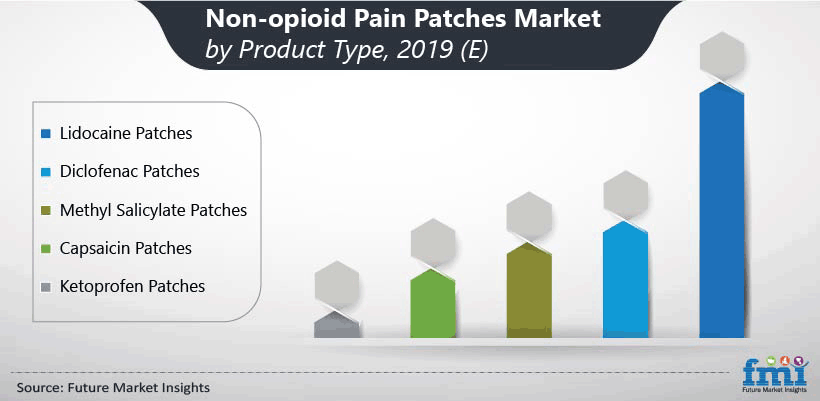
Non-opioid Pain Patches Market Demand, Growth Analysis, Supply, Segmentation & Insights 2029
In recent years, non-opioid pain patches have gained huge attention of leading industry players due to the addictive risk and safety concerns of alternative opioid pain analgesics. In addition, governments and regulatory bodies are encouraging non-addictive alternative therapies for acute and chronic pain treatment. Leading industry players in the non-opioid pain patches market are tapping this opportunity by allocating significant investments towards the R&D of novel transdermal non-opioid pain technologies. Continuous innovation in these novel drugs is expected to drive the non-opioid pain patches market in the decade ahead. Key manufacturers operating in the market are offering a wide range of products such as lidocaine patches, diclofenac patches, methyl salicylate patches, capsaicin patches, ketoprofen patches, and others. Owing to the non-addictiveness of non-opioid pain therapeutics, there has been increasing demand for non-opioid pain patches, creating opportunity for the growth of the non-opioid pain patches market.
FMI – a well-established name in the market research domain – forecasts that, the non-opioid pain patches market will experience a major upturn post 2025, crossing the US$ 4 Bn mark by 2029.
That being said, the market is likely to witness decline in the near term due to the novel coronavirus (COVID-19) pandemic. The impact of the pandemic has been prominent in China, where the virus originated, and Europe – Spain, Italy, and France. Consequently, governments in these regions have imposed total lockdowns, leading to logistic nightmares, and gradual exhausting of existing non-opioid pain patches.
 Non-opioid Pain Patches Market
Non-opioid Pain Patches Market“Rising demand for safe and alternative chronic pain therapeutics, and supportive government policies, are anticipated to shape the future of long-term acting transdermal non-opioid analgesic patches.”
Request For Report Sample @ https://www.futuremarketinsights.com/reports/sample/rep-gb-11286
Key Takeaways of Non-opioids Pain Patches Market Study
- In terms of product type, the lidocaine patches segment is expected to capture over 65% of revenue share in the non-opioid pain patches market.
- Owing to superior topical effectiveness with minimal side-effects and prolonged transdermal drug release, lidocaine patches are the most preferred product type.
- In terms of distribution channel, hospital pharmacies and retail pharmacies & drug stores are expected to collectively hold over 70% of total value in the non-opioid pain patches market during the forecast period.
- North America is the highest revenue generating market by region, due to high R&D projects and conducive regulatory environment for non-opioid pain therapeutics. Europe is expected to offer lucrative opportunities, owing to the large aging population and increasing per capital healthcare expenditure.
Strategic Collaborations – Key Differentiating Strategy Followed by Leading Manufacturers
Leading manufacturers in the non-opioid pain patches market are focusing on external development collaboration to innovate novel therapeutics, in a bid to sustain market competition. For instance, in April 2018, Seattle-based Kineta Chronic Pain collaborated with Genentech to develop a non-opioid drug for the treatment of chronic pain. The underdevelopment drug is α9/α10 nicotinic acetylcholine receptor (nAChR) antagonists, a novel target for the treatment of chronic neuropathic pain.
Want more insights?
A new study by Future Market Insights on the non-opioid pain patches market opines on the indications of non-opioids pain patches from 2014–2018, and presents demand projections for 2019–2029, on the basis of product type (lidocaine patches, diclofenac patches, methyl salicylate patches, capsaicin patches, ketoprofen patches, and others) and distribution channel (hospital pharmacies, retail pharmacies & drug stores, and online pharmacies), across seven prominent regions.
Speak to Analyst, Questions Related To Report @ https://www.futuremarketinsights.com/ask-question/rep-gb-11286
Table of Content
- Executive Summary
1.1. Global Market Outlook
1.2. Demand Side Trends
1.3. Supply Side Trends
1.4. Technology Roadmap
1.5. Analysis and Recommendations
- Market Overview
2.1. Market Coverage / Taxonomy
2.2. Market Definition / Scope / Limitations
2.3. Inclusions and Exclusions
- Key Market Trends
3.1. Key Trends Impacting the Market
3.2. Product Innovation / Development Trends
- Market Background
4.1. Macro-Economic Factors
4.1.1. Global GDP Growth Outlook
4.1.2. Global Healthcare Outlook
4.2. Forecast Factors – Relevance & Impact
4.2.1. Research and Developmental Activities
4.2.2. Technological Advancement
4.2.3. Adoption of Non-opioid Pain Patches
4.2.4. Cost of Non-opioid Pain Patches
4.2.5. Increasing Pain Epidemic
4.3. Market Dynamics
4.3.1. Drivers
4.3.2. Restraints
4.3.3. Opportunities
- Market Context
5.1. Product USPs/ Features
5.2. Product Adoption / Usage Analysis
5.3. Regulatory Scenario
5.4. Pain Epidemiology
5.5. Key Promotional Strategies
- Global Non-opioid Pain Patches Market Value (US$ Mn) Analysis 2014-2018 and Forecast, 2019-2029
6.1. Historical Market Value (US$ Mn) Analysis, 2014-2018
6.2. Current and Future Market Value (US$ Mn) Projections, 2019-2029
6.2.1. Y-o-Y Growth Trend Analysis
6.2.2. Opportunity Analysis, 2019-2029
- Global Non-opioid Pain Patches Market – Pricing Analysis
7.1. Regional Pricing Analysis By Product Type
7.2. Pricing Break-up
7.2.1. Manufacturer Level Pricing
7.2.2. Distributor Level Pricing
7.3. Global Average Pricing Analysis Benchmark
The post Non-opioid Pain Patches Market Demand, Growth Analysis, Supply, Segmentation & Insights 2029 first appeared on Market Research Blog.
Editor Details
-
Company:
- MARKITWIRED
- Website:
